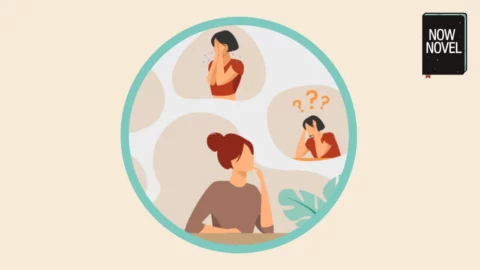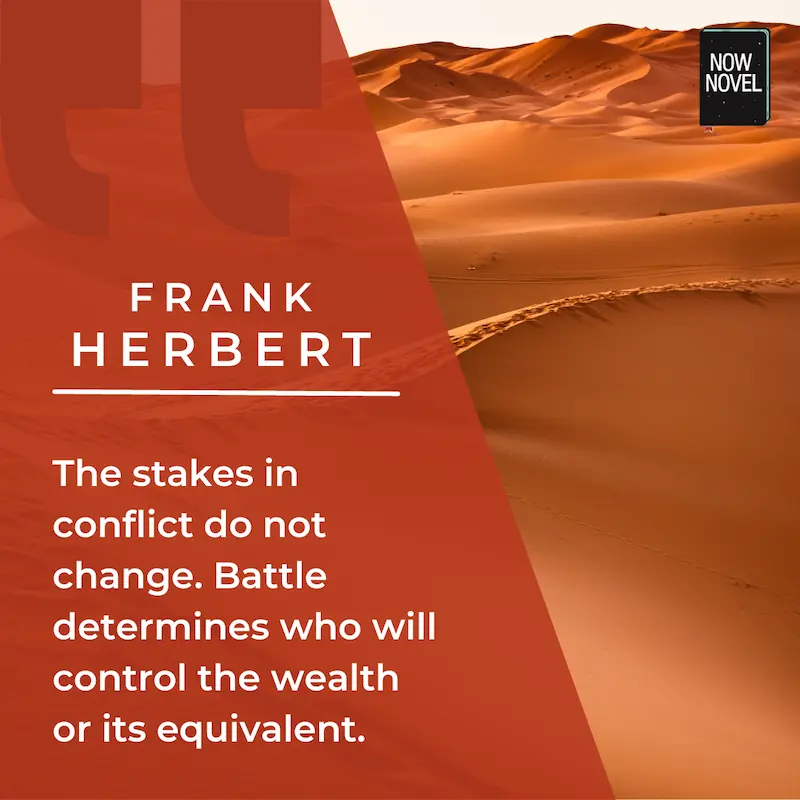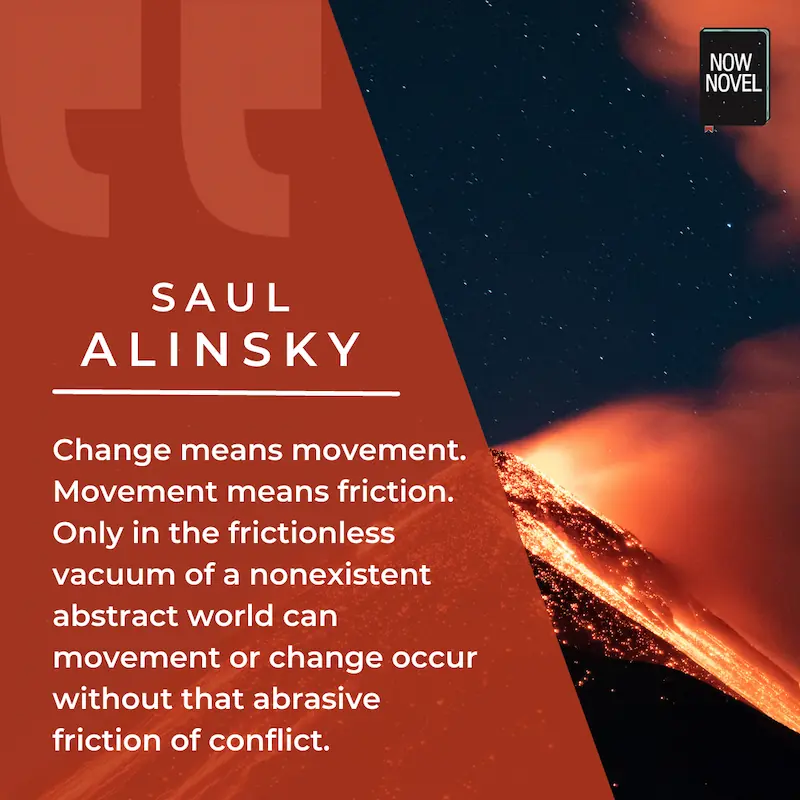In plot – as in life – conflict is a core driver of action and reaction, dilemmas and decisions. Conflict – with others or within a person – prompts change. Internal and external conflict make stories move. Read 7 tips to strike up adversity in stories and make plot conflict matter.
How to plot conflict:
To plot conflicts that stoke tension while making your story develop:
- Start with goals and motivations
What do characters want to have or do? Plot conflict most often arises from characters’ urgent needs or values being unmet or willfully opposed.
- Understand types of plot conflict
Learn about internal and external conflict, as well different types of internal and external conflict that drive story events.
- Find flaws in best laid plans
Just as characters’ flaws may lead to conflict (for example, being overly critical of others), so can flaws in plans. Find a rule, surprise, or opposing aim a person didn’t account for.
- Explore power dynamics
Conflict often erupts from unstable or tense power dynamics (such as the concept of a ‘power vacuum’, a rulership position that will be filled).
- Keep your story’s central conflict in mind
For cohesive plot structure, subplots and secondary plot conflicts should tie back to the central conflict.
- Find stakes that necessitate conflict
For plot conflict to matter, confrontation has to be necessary. Why does the war need to happen (at least, from the war-monger’s perspective).
- Plan how story conflict will resolve
Having an inkling of how plot conflicts will resolve in the final analysis will help to ensure overarching structure. A sense of drive towards your story’s endgame.
Let’s explore these ideas about plot and conflict deeper:
Start with goals and motivations
Conflict literally means (in its Latin roots) ‘to strike together’.
When goals (what characters want) and motivations (why they want it) are contested or in competition with other goals and reasons, conflict – a clashing of swords or words – results.
In Debra Dixon’s writing manual, GMC: Goal, Motivation and Conflict (1996), she writes:
The craft books on my shelves call these three elements by a variety of different names:
Goal – desire, want, need, ambition, purpose
Motivation – drive, backstory, impetus, incentive
Conflict – trouble, tension, friction, villain, roadblockRegardless of what you call GMC, the bottom line is that these three topics are the foundation of everything that happens in our story world.
Debra Dixon, GMC: Goal, Motivation and Conflict (1996), ‘Introduction’, p. 2.
So what do your characters desire, want, need? What are they ambitious about? What is the purpose they serve (and will fight tooth and nail, if necessary, to keep serving?). Write ideas down, and you’re on your way to intriguing plot conflict.
Understand types of plot conflict
Before we look at flaws and power dynamics and their role in story conflict, a brief overview of conflict types in plot.
Internal conflict
The inner struggle, doubt, or state of ‘split’ desire a character faces. Often called ‘man vs self’ or ‘person vs self’.
For example, a character’s internal conflict may be whether to accept a job offer in a city they’ve dreamed of living in forever, knowing they would have to leave an ailing or vulnerable parent behind.
Great inner conflicts lead to difficult choices, i.e. dilemmas. A dilemma is a hotbed of suspense, and a cause for your reader to keep turning pages.
External conflict
The conflicts between characters and other, oppositional forces. These may be:
- Other characters or ‘person vs person’ (villains, rivals, frenemies, toxic family, etc.)
- Environment or ‘person vs environment’ (brutal terrain, wild creatures, and so forth)
- Society or ‘person vs society’ (the attitudes, morals, or public policies a person faces forming a kind of systemic oppression, e.g. racism, misogyny or homophobia)
- Paranormal or ‘person vs supernatural’ (such as a malevolent entity that is not fully human or explicable by rational science or physics)
External conflict is the opposition that is beyond your character’s control in that it is an external agent with its own, not always knowable or transparent agenda.
Now Novel writing coach Romy Sommer shares tips on creating conflict from our writing craft webinars:
Recommended reading
Read articles about types of conflict if you would like to explore this area further:
- Using conflicts in a story: 6 helpful conflict examples
- Making external conflict compelling: 6 ideas
Develop your story’s plot and conflicts
Get writing tools and join a caring critique community to create the plan and accountability to finish.
LEARN MORE
Find flaws in best laid plans
Trouble, tension, frictions, villains, roadblocks – a kink in the best-laid plan is all it takes for things to go south.
It may help for you to think about plot conflict as complications. Plot development questions on story conflicts will help you think up conflicts that truly test your characters.
The high-schooler plans on sneaking out their window to go to the verboten party (a classic plot point in shows about teens like Dawson’s Creek and Twin Peaks). The flaw is their parents’ room is next door and their parents hear the squeak of their kid’s sash window through their own ajar one. Reaction: they yell at their kid to come back from upstairs as the teen runs to an older friend’s waiting car.
Those squeaky windows are the things your character can’t count on. The giveaways, betrayals, surprises, the ‘but…’.
A simple exercise to find the flaws in characters’ plans is to write sentences in the form ‘My character wants to … , but … ‘.
In the conjunction is the plot conflict of an unexpected, unfortunate series of events.
Explore power dynamics
Conflict and confrontation are inevitable when there are untenable, unequal power dynamics.
You only need to look to the global news cycle for examples.
‘Power dynamics’ itself refers to the inevitable movement in conflict. Conflict is tectonic – when plates push up against each other, earthquakes and volcanic eruptions may result.
There is a masterful passage from Toni Morrison’s Song of Solomon where she shows the painful, toxic power dynamic between a father who carries a lot of anger and his daughters, using an extended volcanic metaphor:
Solid, rumbling, likely to erupt without prior notice, Macon kept each member of his family awkward with fear. His hatred of his wife glittered and sparked in every word he spoke to her. The disappointment he felt in his daughters sifted down on them like ash, dulling their buttery complexions and choking the lilt out of what should have been girlish voices.
Toni Morrison, Song of Solomon (1978), p. 10.
In an interesting power dynamic, conflict can feel imminent in your story even when not much is actually going on. There is narrative tension in conflict as a way, more than one single event – the way of Macon’s ingrained anger in the passage above exemplifies this.
Keep your story’s central conflict in mind
A central conflict or main conflict is the primary issue, trouble, roadblock or villain your main characters will need to overcome. The events of your story need to not stray so far from your central conflict that it is lost.
One problem many writers run into when they begin to write their novels is that they have an idea about the main conflict, but it is too easily resolved.
When plot conflict resolves too easily: Andrea’s restaurant
For example, maybe the story is about a woman, Andrea, whose dream is to open her own Italian restaurant, but she lacks the funding and experience to do so.
Andrea meets an Italian chef whose brother wants to invest in a new restaurant, and before she knows it, she has her own restaurant and an experienced chef who can teach her everything she needs to know.
This resolution is so simple that there might as well be no conflict at all.
Novel-length stories in particular need for conflicts to complicate the situation and for the stakes to be raised in order to keep the reader’s attention.
‘But’ and ‘Therefore’ grease the wheel of conflict
In the chosen example above, Andrea might find the Italian chef with the wealthy investing brother, but they have already committed to opening another restaurant. Therefore, they cannot work with Andrea, so she has to look elsewhere for her dream situation.
This ‘therefore’ follows on from the ‘but…’ mentioned above. Or, in other words, it is a chain of reaction (a dilemma and decision) following on from the events that lead up to a ‘but…’ (the action of events driven by a clear motivation, goal, and a conflict/roadblock).
Ways to build conflict into your plot
Here are some ways to build the major conflicts throughout your novel:
Establish what line your character would never cross, and then place your character in a situation where she is forced to face crossing that line.
From telling a lie to killing someone or betraying a loved one to putting her own family in danger, you create conflict and raise the stakes higher when you know your character well enough to know the one thing she would never do – and then make her face having to do it.
Establish your character’s greatest fears, and make her face them. Is your character terrified of heights, water, surgery, losing a loved one, losing her job, becoming homeless or having her heart broken?
As with making your character face a line she does not want to cross, conflict has more impact when it cuts to the heart of what your character is most afraid of.
Have your character experience conflict with friends and family. This isolates your character and puts her in a more vulnerable position. It also has the bonus of making your story more realistic.
Most people are not surrounded by a team of people who constantly praise and support us unconditionally. That’s not a protagonist your reader can root for – that’s a Mary Sue.
Find stakes that necessitate conflict
In plot, conflicts that matter have stakes attached.
If your character says ‘Oh no, I don’t know what to eat for breakfast!’ that is a very minor inner conflict, and likely not even worth mentioning (unless it is a detail important to your plot or character development, e.g. it established that your character is indecisive).
Internal and external conflicts that have higher stakes – consequences riding on how they resolve – make conflict necessary. There’s a ‘no way out but through’ element. Whether it’s Bruce Willis clearing the hijacked building in the Die Hard franchise, or Frodo having to destroy the One Ring for Sauron’s otherwise inevitable rise to total power can be stopped.
What’s riding on your characters’ ultimate success? What is the absolute worst case scenario? Therein lie the risks, the costs they absolutely cannot afford to pay.
Plan how story conflict will resolve
Your character should mostly attempt to resolve conflicts as they arise; sometimes those attempts should succeed, sometimes they should fail and sometimes they should make matters worse.
You can also use the rule of threes for at least some of your attempts at conflict resolution.
The ‘rule of threes’ simply states that a character should make three attempts to solve a problem and the first two should fail. Of course, following this rule without variance leads to predictability. Yet it’s not a bad principle to keep in mind to remind you that things should never be too easy for your characters.
What do you find challenging in plotting and conflict? Share your questions and thoughts in the comments!
Develop your story’s plot, characters and conflicts in structured steps with writing tools and constructive feedback.



